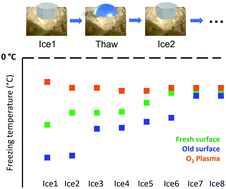Freezing efficiency of feldspars is affected by their history of previous freeze–thaw events†
Abstract
Among the different aerosol mineral particles that contribute to induce ice nucleation (IN) in the troposphere, feldspars have been identified as the most active. Nevertheless, which surface properties make some feldspars more efficient than others, i.e. able to induce IN at higher temperatures, is still unclear. In addition to that, surface properties of such materials can change as they are exposed to a variety of environmental conditions while traveling through the troposphere. Here, freezing temperature of water droplets deposited on feldspar minerals has been measured as a function of consecutive freeze–thaw cycles. We found an increase of the freezing temperature for the initial cycles followed by approximately constant freezing temperature for consecutive cycles. We call this a “history effect”. This effect is more evident for samples aged in standard room conditions and it disappears if the sample is exposed to oxygen plasma. Oxygen plasma generates OH groups at the surface, facilitating IN and cleans the surface from organic contamination, unblocking pores at the surface, believed to be the most active IN sites on feldspars. A similar process is suggested to happen during the history effect, when consecutive freeze–thaw events unblock IN sites.



 Please wait while we load your content...
Please wait while we load your content...